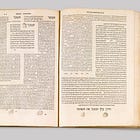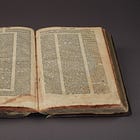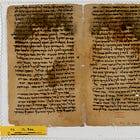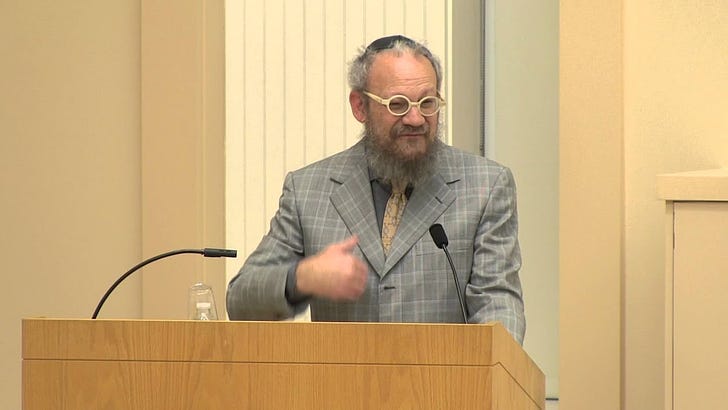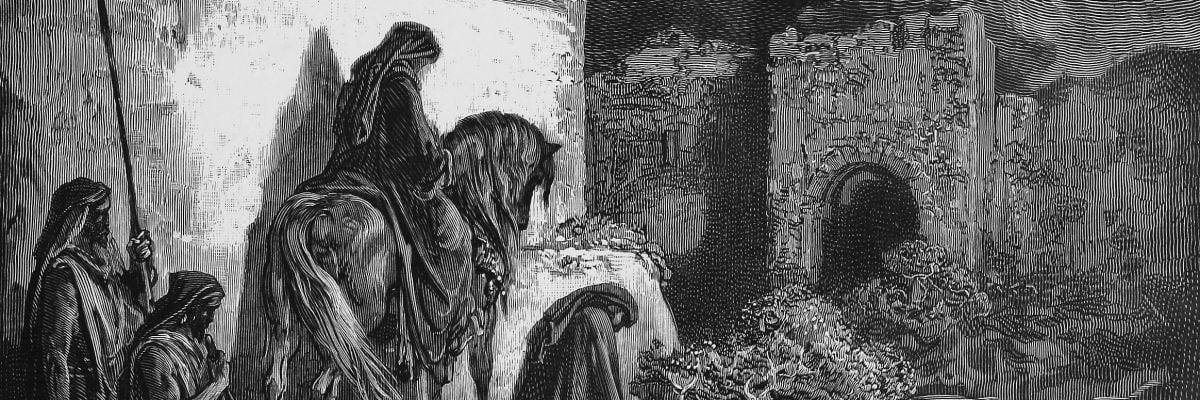On How and How Not to Read The Talmud (VI)
An excursus on Mishnah, the Midrashim and Targumim, and the figure of the Annointed for War.
Welcome back, we are, I say again, near the end - the majority of the rest of the mateiral we have to cover is more specific criticism and methodological concerns required to draw conclusions. My Guess is two or three installments, depending on how much exacting detail I want to bring up from footnotes. Now, we cover the Midrashim and Targumim, before a final evaluation of questionable secondary sources, and the conclusions we can draw from our investigations.
And, regarding current events, there is little to say other than the words of R’ Pinchas ben Yair:
מִשֶּׁחָרַב בֵּית הַמִּקְדָּשׁ, בּוֹשׁוּ חֲבֵרִים וּבְנֵי חוֹרִין, וְחָפוּ רֹאשָׁם … וְגָבְרוּ בַעֲלֵי זְרוֹעַ וּבַעֲלֵי לָשׁוֹן, וְאֵין דּוֹרֵשׁ וְאֵין מְבַקֵּשׁ, וְאֵין שׁוֹאֵל
יהמו נא רחמיך
also, as classes are finished for the year, and there are only now exams coming up, updates will be more frequent (hopefully).
previous installments are here, and should probably be read first:
Earlier material from the Midrashim and Targumim, probably from the Talmudic period have a figure who is an “anointed for war” (משוח מלחמה). As Boyarin points out,1 the word here is not משיח (mashiach, messiah) but משוח (mashuach)– the literal meaning of both terms is “anointed”, but they are not equivalent, with the latter often used for regular priests in earlier literature, in Mishnah and Talmud there is no reference to either mashuach generally or mashuach milchamah (the war-annointed) which doesn’t clearly describe a regular priest (see M Sotah 8:1 and the citation of Deuteronomy 20:2, M Makkot 2:6, historically applied to the biblical Pinchas in the later Vayikrah Rabbah 20:2 etc). Boyarin, on this basis, calls Midrash “a chimera.”2 However, at some point it appears one is read into the other, which is not difficult given that both words are derived from the same root, and one of the most common scribal errors is to mistake a vav, ו for a yod, י. The question is whether this is prior to, or after, this passage in the Bavli. Clearly this earlier version of the figure has little similarity to any elements of Christian belief. In fact, this role is far closer to the description of the roles of Judah Maccabee and his brothers in 2 Maccabees. Compare the following, from Mishnah Sotah 8:1:
[regarding] The Anointed for War [Mashuach Milchamah] in that hour he shall speak to the people, in the holy tongue he will speak, as it is said: “Before you join battle, the priest shall come forward” [Deut. 20:2]. This is the Anointed for War. “And [he will] address the troops” [same verse]. And he will say to them “Hear, O Israel” [Shema Yisrael].
With this, from 2 Maccabees 8:21-23 (NRSV):
With these words he filled them with courage and made them ready to die for their laws and their country; then he divided his army into four parts. He appointed his brothers also, Simon and Joseph and Jonathan, each to command a division, putting fifteen hundred men under each. Besides, he appointed Eleazar to read aloud from the holy book […] leading the first division himself, he joined battle with Nicanor.
Judah takes a similar, though less ceremonial role, rousing his troops with speeches throughout first Maccabees. Note, also, that he and his brothers come from a priestly family.3
In the Aggadic Midrash this war-anointed figure appears, associated with the north deviating from the Mishnaic usage but not (yet?) conflated with a Messiah, or Messiah of the North. Following Boyarin I see no reason to read this figure here as a Messiah, particularly as the Messiah is also named alongside this figure multiple times. This figure is also at some point connected to Zechariah’s Four Craftsmen. In Pesikta D'Rav Kahana 5:9 (roughly contemporary to the Yerushalmi though possibly completed later) the war-anointed is identified as one of the Four Craftsmen, alongside the Messiah. This passage also quotes the 4th Century coda from Mishnah Sotah, and equates the “wicked Kingdom” (i.e. Rome) with Edom, “enticing” and “enslaving” the Jews, which is a common motif equating both Rome and Edom with Christianity.
In other Midrashim and later Targumim this is further connected to with a northern Messiah, as in the Talmudic-period Bereshit Rabbah 99:2, and 75:6. Interestingly in the later passage here this figure is named alongside “King Messiah, ” both figures are independent, and this is attached to prophecy normally associated with the Davidic messiah (Zechariah 9:9) - and in the former, this Anointed for War is “opposed to Rome”, but of the tribe of Joseph, not Levi. It appears a war-anointed who comes from Joseph (not from the sons of Aaron) has not yet been fully raised to Messianic status in either,4 this war anointed is either alone, as in the former, or alongside and thus separate in the latter. These are the earliest passages to make this connection, which continues through the post-Talmudic Bamidbar Rabbah 14:1 (possibly compiled as late as the turn of the millennium, with this material being part of the latter extension of the Midrash) quoting Psalms 80:3, following the Zechariah verse about the Craftsmen, the midrash describes “a messiah who arises from the sons of Manasseh… this is a war-anointed one who comes from Ephraim” (my translation) followed by a citation of Deut 33:17 presenting a restoration eschatology. This also appears to be an exegetical oddity, as to be called “war-anointed”, a distinctly priestly role in the Mishnaic literature, you would have to be of the Tribe of Levi. This casts further doubt about the earliness of the emergence of this idea. In the probably Islamic-Era Targum Pseudo-Jonathan on Exodus 40:11 we have a Messiah, son of Ephraim (mashicha bar Ephraim in the Aramaic), with the priestly role completely absent.5 Targum Shir Hasharim (Song of Songs, mentioning Mashiach ben Ephraim in 7:4) is also at its earliest post-Islamic, and possibly even later.6 In none of these Midrashic passages is this figure described as dying.
Earlier, however, in the 7th Century, just before the Islamic conquest of the Persian Empire, comes Sefer Zerubbabel, which also shows extensive Christian influence and demonstrates probably the earliest attestation of this fully developed eschatology, in which this figure is identified as a Messiah from Joseph, who dies, and is resurrected by the Davidic Messiah.7 By the medieval period this development has stabilized, cementing that figure as playing this role in some sectors of medieval Rabbinic thought. The relationship between these ideas depends on how one theorizes dependence: either Boyarin is right, and the exegesis in the Yerushalmi is the origin, splitting off a single Messiah into two; or alternatively it may be the elevation of a previously non-messianic warlike priestly figure, equated with the north, to the role. When dying, and the term messiah, and association with the tribes of Ephraim and/or Manasseh are attached to the war-anointed figure is unclear, but this is only attested late; there is no pre-Talmudic period record, and the elements first appear independently of each other and are then slowly developed brought together over half a millennium. That there is an increasing complexity and elaboration from the earlier texts to the later ones suggests that this idea is a creation of the Rabbinic period. None of the texts featuring this figure that I have surveyed prior to Sefer Zerubbabel include reference to Isaiah 53, and it is unclear if the idea of a northern messiah even exists prior to the Bavli.8 Sefer Zerubbabel may even be the origin of the Talmudic Mashiach Ben Yoseph, if the insertion of this appellation, absent from any earlier source, is the product of the Stammaim, as David Weiss Halivni dates their work to the mid-sixth to mid-eighth centuries.9 That even the clearly messianic identification of this figure is absent from all the early sources requires explanation. I strongly believe that the persistence into the modern period of identification of the mashuach milchamah as directly equivalent to this figure does not account for the textual record and is an anachronistic projection of medieval equivalencies onto prior texts. If it were this straightforward there is no accounting for use of the word in earlier texts to clearly refer solely to priests, with this association extending well into the Amoraic period. Both the figure in the Bavli and Sefer Zerubabbel further cannot directly be equated with the far earlier attestation of expectation of a priestly messiah, as that would entail being ben Levi or ben Aharon, and this condition extends to the one Annointed for War, who also needs to come from that lineage.10
Thus, it is striking that this Messiah, who is from the North (implicitly including the Galilee) and does die is a “son of Joseph,” in stark contrast to the Judahite, Davidic Messiah, whose restored kingdom will (at the very least) include both Judah and the historical Northern Kingdom, and who is exclusively responsible for the resurrection of the dead. But further, that the name here is Joseph rather than Ephraim (the more common toponym for the north) appears to be purposeful. The idea that Carrier finds so striking and describes as a “Christ son of Joseph” is indeed remarkable, but that designation looks like evidence of dependence than independence, given that it is juxtaposed directly with the Davidic messiah and there is no other apparent reason for preferring Joseph over Ephraim, when the latter (or Manasseh, or both, as they are proper tribal affiliations) seems preferred for both the war-anointed and the later messiah through the later Midrash and Targumim, where these two figures are equated. While Boyarin presents a different interpretation of this than the hypothesis I propose here, he comes to the same conclusion, that this is an apologetic move in response to Christian claims.11
Returning to the Bavli, this vision from Zechariah is placed in that final eschatological conflict, after which comes peace. For this peace, we are presented with the framework from Micah. Note that, instead of two Messiahs here, we have one, alongside Elijah, and the other figures listed. This is a return to the simple version of mainstream Rabbinic messianism, as presented in the Sanhedrin passages above, responding to Mishnah Sotah 9:15 (the conclusions may be compared, as both include Elijah, David and the Messiah). The Zechariah prophecy comes before and the Micah comes after, bringing the two together. However, in the final framework of messianic peace there is no mention of Mashiach Ben Yosef – which may imply that he wasn’t resurrected at all. The final framework is oriented around David and the Messiah, so this is the Davidic one. This also appears to be an attempt to reconcile different, separate eschatological ideas, which are not previously harmonized.
Also of importance is the exegetical eclecticism here, the various connections that are made between all these different prophetic books – but bar the late Sefer Zerubbabel there is the complete absence of Isaiah 53 in relation to this northern messiah tradition. The only Messianic readings of that passage prior to the Medieval period are BT Sanhedrin And Targum Jonathan.12 And, in the latter, which is the earliest, the suffering is of the people, not the messiah at all. The dying Messiah and Isaiah 53 are not related by the Rabbis anywhere prior to the 7th Century. If there were a known conceptual connection between these one would expect it to be presented somewhere in one of these pre-Zerubbabel passages about a Northern Messiah, but it is not. However, there is also no apparent strict apologetic avoidance governing the connection between Isaiah 53 and the Davidic Messiah, who, in the Rabbinic literature, is never described as dying (bar the implication in Yerushalmi), as the Sanhedrin passages, the Targum, and many other later examples in the later Rabbinic tradition attest.
This may not be straightforward to someone solely familiar with, and thus preconditioned by, the Christian interpretative tradition on Isaiah, but the reason is probably simply that it was read allegorically. Boyarin’s comments on this may be easily misread. He writes that “until the last few centuries, the allegorical reading was a minority position,”13 but the specific allegory he is speaking of is that Isaiah’s servant is the Jewish people.14 This “allegorical” reading he is presenting is more abstract, and, indeed, its popularity is a modern phenomenon, in contradistinction to the one that one finds throughout the later Rabbinic tradition – either we get, according to some, the reading we have seen being developed in the previous exegesis, that there’s a messiah who dies but it’s not the Davidic one; or, in other places, the Messiah of David suffering, but the verses concerning death and the grave are metaphorical. And the original, primary reading of the passage that all these readings are dependent on – that of this passage being about the Messiah at all – is allegorical as well, given that the word Messiah never occurs within it. Famously, the only use of the noun “Messiah” in all of Isaiah is in 45:1 naming the Persian king Cyrus the Great as that figure. (The verb “to anoint” is also used once, but this is in 61:1). But this Jewish Davidic-messianic reading continues into the modern period and is represented in many stories preserved in the Chassidic traditions, such as the Baal Shem Tov’s meeting of the Messiah on the way to Posen.15
next post:
Boyarin, The Jewish Gospels : the story of the Jewish Christ, 188-9n19.
Ibid.
As per 1 Macc. 2:1-5.
Note also here the opposition between Joseph and Edom, the latter being the metonym for Rome, and often Christianity.
This text is often attributed simply as Targum Jonathan, but the entire Targum of that name on the Torah is mis-attributed, anonymous, and written so late it contains elements demonstrating Islamic influence. This pseudonymous naming convention is a result of typesetting errors, well after the dawn of printing, thus an extremely late (mis)attribution. The priests are present in the verse this passage is elaborating on, but this messianic figure is decidedly not a priest, but rather a second Joshua.
Andrew W. Litke, "Following the Frankincense: Reassessing the Sitz im Leben of Targum Song of Songs," Journal for the Study of the Pseudepigrapha 27, no. 4 (2018), 289–313.
See the book-length treatment of this document in Himmelfarb, Jewish messiahs in a Christian empire: a history of the Book of Zerubbabel. In my reading of this I was pleasantly surprised to find I have come to the largely same conclusion regarding the pre-Rabbinic provenance of the Northern Messiah tradition, contra David C Mitchell, see 101-105. However, I am far more cautious than her. See 108-113. Other problems with Mitchell’s analysis, requiring some adjustment of her assessment, will be addressed below.
Note that if this alternative origin I propose is correct it casts even more doubt on popular readings of the already highly dubious Hazon Gabriel, which is an unprovenanced artifact the authenticity of which is disputed, and, even if it is authentic the readings of the fragmentary text on it are also contentious, including the presence of the word “Ephraim” (line 16) and the word “live” (in line 80). See Årstein Justnes and Josephine Munch Rasmussen, "Hazon Gabriel: A Display of Negligence," Article, Bulletin of the American Schools of Oriental Research 384, no. 1 (2020), https://doi.org/10.1086/709464.: 69-76 for questions of authenticity and provenance; and Collins, Adela Yarbro, “Response to Israel Knohl, Messiahs and Resurrection in ‘The Gabriel Revelation’”, in Matthias Henze, ed., Hazon Gabriel : new readings of the Gabriel revelation, Early Judaism and its literature ; no. 29 (Atlanta: Society of Biblical Literature, 2011). 93-7, for a detailed rebuttal of Israel Knohl’s highly speculative reading. To extrapolate a northern messiah from a word which can be read as אמרים/אמדים/אפרים - “Ephraim”, “stood” or “spoke” is dubious. The same is true for the appearance of חאיה “live” which even the majority of scholars who accept the authenticity of the artifact do not see in that line, instead reading האו֗ת, “the sign”, this reading has been accepted by Knohl himself, see his “The Apocalyptic and Messianic Dimensions of the Gabriel Revelation in Their Historical Context” in the same volume, 43n12 and 55. The latest transcription of the proposed text with extensive notes is available here: http://www.jjmjs.org/uploads/1/1/9/0/11908749/elgvin_gabriel_inscription.pdf
My opinion is fortuitously also supported by Martha Himmelfarb, on all points but the reading of the name Ephraim, see Himmelfarb, Jewish messiahs in a Christian empire: a history of the Book of Zerubbabel, 106-7. This perspective demonstrates that even if one reads Ephraim here, the implications of that drawn by Knohl do not necessarily follow.
Halivni, Formation of the Babylonian Talmud, 8-11.
If, indeed, following 1QS, the Yachad at Qumran did expect two messiahs, that one is of Israel and the other of Aaron dispels any idea that there is a northern messiah to be found here. Qumranic literature is extremely concerned with the proper divisions of people according to lineage and “seed”, the separation of Israel from the nations, and the distinction of the Levites from Israel, and of Priests from Levites – and, it seems, the sons of Tzaddok from regular priests. There is a hope for a restoration of the united kingdom of Israel, and the northern tribes, but no conception of a northern messiah. 1QS 9:11 and CD 6:21/4Q266 describe Messiahs of Aaron and (presumably united) Israel, not Israel and Judah.
This is a slightly different argument toward similar conclusions to Himmelfarb, Jewish messiahs in a Christian empire: a history of the Book of Zerubbabel, 112-13. She is far more sympathetic to the idea of this tradition being pre-existent in the early Rabbinic period, but even her argument, and that of Zellentin that she takes issue with, do not clearly attest to anything before that, and describe extensive Christian influence. Given all the previous citations demonstrating the lateness of much of the Bavli aggadah, and its presentation of a very particular, systematizing ideological position, the derivation of “popular” beliefs from this text is problematic.
To my knowledge, after scouring all the indexed references to every single verse in the servant song in the Rabbinic Literature on Sefaria. One only needs to read this Targum on the Isaiah passage in question to see that its interpretation is fundamentally different to the Christian one. The suffering is that of the people of Israel, not the messiah, and the messiah rescues Israel from that suffering. A translation of this is freely available.
Boyarin, The Jewish Gospels : the story of the Jewish Christ, 152.
It is also worth considering that the idea that the one who suffers in Israel is reflected in the early Targum (linked in note 12 above). Dating on this varies from the first to third centuries (it was possibly composed early but edited later). This reading also persists throughout the tradition.
A very readable translation of this story is available in Zalman Schachter-Shalomi and Netaniel Miles-Yepez, A Heart Afire: Stories and Teachings of the Early Hasidic Masters, Philadelphia: Jewish Publication Society, 86-94.


